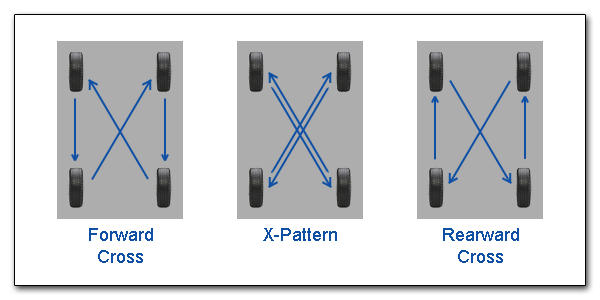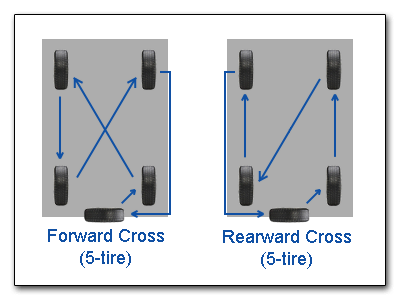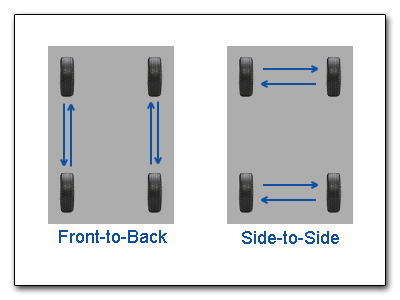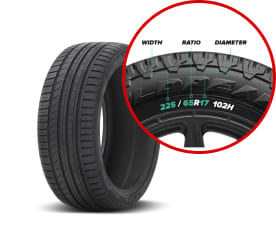Tire Rotation Guide
A tire's ability to carry a heavy load primarily depends on its air pressure. If a car has an underinflated tire, the car's weight puts pressure on the tire and distorts its round shape, overloading it and impairing the tire's ability to roll smoothly. When the tire is inflated, the densely packed air inside the tire pushes back against the vehicle's weight, maintaining the tire's roundness and allowing it to roll properly without excessive friction or heat buildup.
Rotation Patterns
Generally, tires should be rotated every 5,000 miles or 6 months, which typically means at the same time as your oil change. Your owner's manual will indicate when and how your tires should be rotated. During tire rotation, the wheels and tires are removed without being dismounted. Each wheel and tire is then put on a different axle position, based on a specific pattern. Depending on your vehicle, most vehicle manufacturers recommend one of three standard tire rotation patterns:

Forward Cross: Recommended for front-wheel drive vehicles. The front tires move straight back to the rear axle, while the rear tires cross diagonally to the opposite side of the front axle.
Rearward Cross: Recommended for rear-wheel drive or four-wheel drive vehicles. The rear tires move straight forward to the front axle, while the front tires cross diagonally to the opposite side of the rear axle.
X-pattern: This is a common alternative to the forward-cross or rearward-cross pattern. All four tires cross diagonally, with each front tire moving to the opposite side of the rear axle and each rear tire moving to the opposite side of the front axle.
In general, the rule is to cross-rotate whichever tires are moving to the drive axle, which puts more stress and wear on the tires. Once a set of tires have been rotated, every subsequent rotation for those tires should follow the same pattern. Rearward cross rotation is often employed on four-wheel drive vehicles because every tire eventually rotates to all four positions, while X-pattern rotation only moves each tire between two positions.
Spare Tire Rotation
Tire rotation becomes slightly more complicated for vehicles with a full-sized matching spare tire, meaning that the spare tire is not designated for temporary use, and is the same size as the main four tires. For these vehicles, the owner's manual often includes the spare tire in the rotation pattern in order to balance wear and tread depth across all five tires.

Forward Cross(5-tire): For front-wheel drive vehicles. As usual, the rear tires cross-rotate to the front while the left front tire rotates straight back. The spare tire moves to the right rear, and the right front becomes the spare.
Rearward Cross (5-tire): For rear-wheel drive and 4-wheel drive vehicles. As usual, the rear tires move straight up to the front while the right front tire crosses to the left rear. The spare tire moves to the right rear, and the left front becomes the spare.
These patterns ensure that the spare tire wears at the same rate as the others, and help to minimize any handling issues if the driver needs to replace a flat tire with the spare.
Directional and Staggered Tires
However, these rotation patterns assume that all tires are non-directional (i.e. can roll in either direction) and that all wheels and tires have the same size and offset. Many high-performance vehicles today have directional tires or staggered wheel/tire fitments, which require special rotation patterns.

Front-to-Rear: For directional, same-sized tires. Each tire moves straight front-to-back while staying on the same side. Since directional tires are intended to roll only in one direction, they cannot cross to the other side of the vehicle, as this would reverse the tread pattern.
Side-to-Side: For non-directional, staggered tires. Each tire crosses to the opposite side of its axle. Since the front and rear have different tire sizes or wheel offsets, each wheel and tire can only be placed on the same axle.
If your vehicle has directional tires of different sizes or with different wheel offsets, each tire will need to be dismounted, remounted on the opposite wheel, and rebalanced during rotation.

